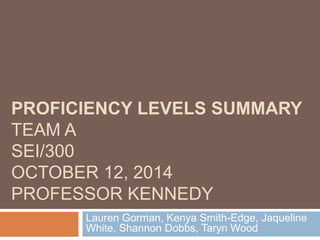
Proficiency levels summary
- 1. PROFICIENCY LEVELS SUMMARY TEAM A SEI/300 OCTOBER 12, 2014 PROFESSOR KENNEDY Lauren Gorman, Kenya Smith-Edge, Jaqueline White, Shannon Dobbs, Taryn Wood
- 2. Introduction A 6th grade science class is to learn and recognize the characteristics and roles of water in a natural environment as well as a human-made environment in all three phases. Students will experience demonstrations, act out a demonstration, work in small groups, and work independently to learn about water. Four different proficiency levels (pre-emergent/ emergent, basic proficient, intermediate, and fluent English proficient) are taken into account and modifications are made.
- 3. Pre-Emergent/Emergent Pre-emergent and emergent students may require more visuals and hands on learning than English proficient readers. Pictures will be utilized to assist students with developing vocabulary. Picture/vocabulary charts will be made available for students to use as a reference during completion of the lesson. Many scientific terms are Latin based and have familiar spellings to students whose first language is derived from Latin, like Spanish, Italian, or Portuguese (August, Artzi, & Mazrum, 2010). Students will use their previous knowledge, associated diagrams, and pictures to decipher new terms. As students develop their new vocabulary, they will become less dependent on diagrams and pictures. However, the tools will continue to be made available to the students. Background lessons need to be developed in order to introduce students to the terms of the lessons prior to the actual lesson. Pretests, word walls, or word clouds can used to determine how much students already know about the three states of water and vocabulary terms associated with them (Echevarria, Vogt, & Short,
- 4. Basic Proficient ELL students who are basic proficient in the lesson of learning about water in the three phases will distinguish the likenesses and differences of water in each of the three phases at the molecular level. Students may inaccurately use key vocabulary and images for the phases and their transitions. Student’s background may be used to help with comprehending the vocabulary. Terms such as evaporation and condensation could be linked to a familiar climate. If a student has obtained basic proficiency in the lesson, he or she will complete the zip-lock activity with many errors. Working in groups for the activity will help students strengthen their communication between each
- 5. Intermediate Low Intermediate High Intermediate According to "Finalized English Language Proficiency (elp) Standards" (2014), “A student at this level is able to comprehend information shared in social and academic conversations. The student initiates and responds to conversations using expanded vocabulary in varied sentence structures. Minimal errors in phonology and syntax may impede the production of language.” According to "Finalized English Language Proficiency (elp) Standards" (2014), “A student at this level is able to comprehend information shared in social and academic conversations. The student initiates and responds to conversations using expanded vocabulary in varied sentences structures. The student demonstrates control of productive language. Minimal errors in phonology and syntax do not impede communication.”
- 6. Intermediate Intermediate students begin to follow multi-step instructions, which contain specific academic vocabulary. With guidance they will begin to respond to questions or statements in an academic discussion. They will also participate in formal and informal conversation tasks. Intermediate students can demonstrate reading comprehension by predicting text using prior knowledge and text features. Writing functional text, such as graphs, falls within the intermediate level. ("Finalized English Language Proficiency (elp) Standards", 2014).
- 7. Fluent English Proficient Students who are Fluent English Proficient are able to understand the lesson about the three phases of water with no errors or mistakes. The student will be able to complete the activity sheet correctly with proper knowledge of the vocabulary that is being used. When prompted to dance slowly to represent the different phases of water, the student will be able to follow verbal instructions on when to dance and how to dance to represent his or her given water phase and will complete the task correctly. Vocabulary that is used during the lesson and the activity will be understandable and comprehendible to the student if he or she is Fluent English Proficient. The student will be able to share and accurately discuss his or her findings or ideas with the group without errors or mistakes. If the student has truly reached the Fluent English Proficient level, then the student will complete the zip-lock activity without any language assistance or errors in the assignment. “Completing the zip-lock activity shows the students are using the English language appropriately and have an understanding on the phase changes vocabulary” ("Siop Lesson Plan Template: Science", n.d.).
- 8. Conclusion All of the students who are ELL need different levels of help throughout the lesson. The pre-emergent student needs far more help than the fluent English student. At the end of the lesson all students should be able to understand the characteristics of water and the roles it takes in all environments and phases.
- 9. References August, D., Artzi, L., & Mazrum, J. (2010). Center for Research on the Educational Achievement and Teaching of English Language Learners. Retrieved from http://www.cal.org/create/publications/briefs/improving-science-and-vocabulary-learning-of- english-language-learners.html Echevarria, J., Vogt, M., & Short, D. J. (2013). Making content comprehensible for English learners: The SIOP Model (4th ed.). Retrieved from The University of Phoenix ebook Collection database. Finalized English Language Proficiency (ELP) Standards. (2014). Retrieved from http://www.azed.gov/english-language-learners/elps/ SIOP Lesson Plan Template: Science. (n.d.). Retrieved from http://www.google.com/url?sa=t&rct=j&q=&esrc=s&source=web&cd=5&ved=0CDoQFjAE &url= http%3A%2F%2Fgeorunner.weebly.com%2Fuploads%2F1%2F0%2F6%2F3%2F106337 80%2Fgr oupc_esledit11_4_reflection.pdf&ei=jeAzVJaONtGoyATghIK4Bw&usg=AFQjCNGLsMGfl_ 32uJVkeTosIYAuwQb_8g&bvm=bv.76943099,d.aWw
Editor's Notes
- This lesson plan is a very good fit for intermediate ELP standards and students that fall within this range score-wise or are working on reaching this score range as a goal.